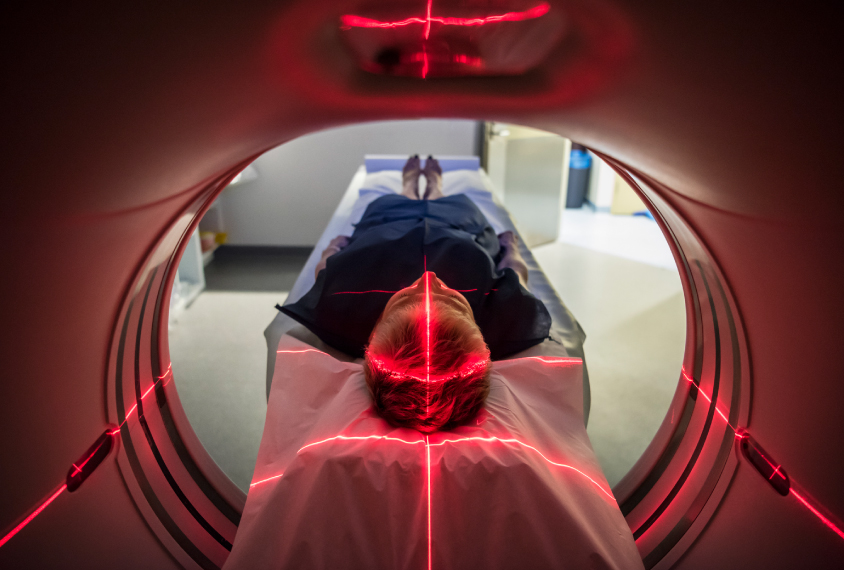
New method muffles noise from body movements in brain scans
A new software program can correct for the confound introduced by head movements and breathing.
Breathing and even the most subtle head movements can introduce noise into brain scans, sometimes with a delay that makes the noise difficult to detect. A new software program allows researchers to mute the effects of those movements, researchers reported yesterday at the 2017 Society for Neuroscience annual meeting in Washington, D.C.
The code can spot the residual noise in functional magnetic resonance imaging (fMRI) scans, allowing researchers to correct it. The researchers plan to release the code; their results are under review for publication.
“If you want to make a claim about individual differences or a group being different than another group, you really want to make sure that these results can’t be hijacked by unaccounted sources of the noise in your data,” says lead researcher Daniel Kennedy, director of the Social Brain Lab at Indiana University in Bloomington. Lisa Byrge, a postdoctoral fellow in his lab, presented the findings.
Researchers have for decades turned to fMRI to study functional differences in the brains of people with various conditions. The technique reveals neuronal activity by detecting changes in oxygen-rich blood flow in the brain. These changes generate the ‘BOLD’ signal.
However, head movements and breathing can influence the signal in complex ways. This is especially problematic in studies involving people with autism, who are known to move in the scanners more than controls do.
Sound scrub:
The subtle body movements can introduce noise with different lag times, the researchers showed. There are some ideas as to how this might happen. For example, movements of the chest while breathing affect the magnetic field of the scanner, changing the BOLD signal almost immediately. A shift in the depth or rate of breaths, on the other hand, can change the level of carbon dioxide in the bloodstream. This gas dilates the blood vessels and can change the BOLD signal tens of seconds later.
The lag also means that studies trying to find synchronous activity between brain regions may be looking at the wrong signals at the wrong times.
“Now the picture is emerging that there are these strong effects, many of which seem to be linked to respiratory effects, and those are very present in the data that people analyze,” Kennedy says.
One method to get rid of the noise is to delete, or ‘scrub,’ the time points in the data at which participants moved the most. But the researchers found noise can occur with a lag: up to 30 seconds after movement.
To measure how individual movements alter the BOLD signal, the researchers analyzed fMRI scans taken from people when their brain was at rest. They zoomed in on the signals within 45 seconds after a particular head movement. Because these brain scans don’t show signals in response to a particular task, averaging them should produce a flat signal. However, the averaged signal isn’t flat, suggesting noise in the scans because of the head movement.
“We were kind of hoping that we wouldn’t see anything, that we would have a flat line,” says Kennedy. “But that was not the case. There are systematic changes that follow the head movement.”
Nearly all movements, including micro ones typically ignored by scrubbing techniques, altered the BOLD signals with a lag of 5 to 30 seconds. Using their program, the researchers found this pattern in scans taken at different times and in different scanners. Scans retained this noise even after they were cleaned up with various methods.
The researchers assessed several statistical methods to subtract the noise from the data. They found that a correction method known as the ‘global signal regression’ works best. Their new program could also be used to test the effectiveness of other correction methods.
“Now we have this very simple method where you can actually visualize the results of your cleanup,” Kennedy says.
For more reports from the 2017 Society for Neuroscience annual meeting, please click here.
Recommended reading

Too much or too little brain synchrony may underlie autism subtypes

Developmental delay patterns differ with diagnosis; and more

Split gene therapy delivers promise in mice modeling Dravet syndrome
Explore more from The Transmitter

During decision-making, brain shows multiple distinct subtypes of activity

Basic pain research ‘is not working’: Q&A with Steven Prescott and Stéphanie Ratté
